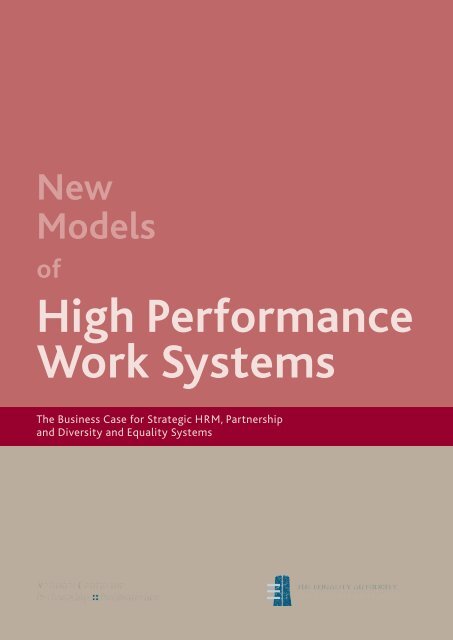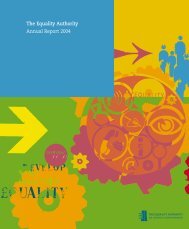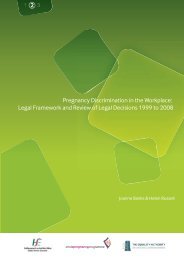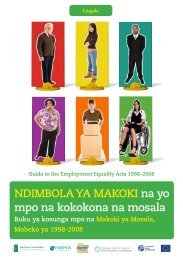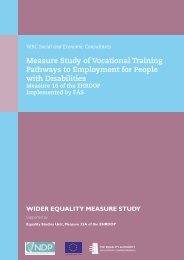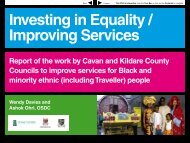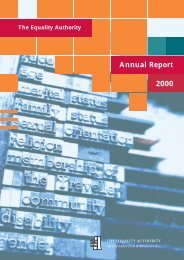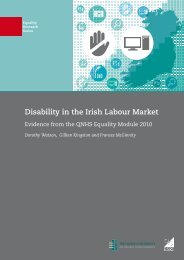New Models of High Performance Work Systems - Equality Authority
New Models of High Performance Work Systems - Equality Authority
New Models of High Performance Work Systems - Equality Authority
- No tags were found...
Create successful ePaper yourself
Turn your PDF publications into a flip-book with our unique Google optimized e-Paper software.
<strong>New</strong><strong>Models</strong><strong>of</strong><strong>High</strong> <strong>Performance</strong><strong>Work</strong> <strong>Systems</strong>The Business Case for Strategic HRM, Partnershipand Diversity and <strong>Equality</strong> <strong>Systems</strong>
<strong>New</strong> <strong>Models</strong> <strong>of</strong><strong>High</strong> <strong>Performance</strong><strong>Work</strong> <strong>Systems</strong>The Business Case for StrategicHRM, Partnership and Diversityand <strong>Equality</strong> <strong>Systems</strong>January 2008Dublin City UniversityPatrick C. FloodThaddeus MkamwaCathal O’ ReganKansas UniversityJames P. GuthrieUniversity <strong>of</strong> LimerickWenchuan LiuClaire ArmstongSarah MacCurtain
First published January 2008 byThe <strong>Equality</strong> <strong>Authority</strong>2 Clonmel StreetDublin 2National Centre forPartnership & <strong>Performance</strong>16 Parnell SquareDublin 1© 2008 <strong>Equality</strong> <strong>Authority</strong> andNational Centre for Partnership & <strong>Performance</strong>ISBN 13: 978-1-905628-72-8The views expressed in this report are those <strong>of</strong> the authors and do not necessarily representthose <strong>of</strong> the <strong>Equality</strong> <strong>Authority</strong> or the National Centre for Partnership and <strong>Performance</strong>.
ContentsForeword 5Authors’ Acknowledgements 8Executive Summary 10Part 1The Search for <strong>High</strong> <strong>Performance</strong>1.1 Introduction 131.2 Organisation <strong>of</strong> report 141.3 Expanding the definition <strong>of</strong> HPWS 14Part 2Research Approach2.1 Methodology 162.2 Sampling 172.3 Pr<strong>of</strong>ile <strong>of</strong> Respondents 152.4 Industry and Company Pr<strong>of</strong>ile 15Part 3A Descriptive Overview <strong>of</strong> <strong>Work</strong>placePolicies and Practices in Irish Industry3.1 Introduction 173.2 Strategic Human Resource Management(SHRM) 203.3 <strong>Work</strong>place Partnership 253.4 Diversity and <strong>Equality</strong> 293.5 Flexible <strong>Work</strong>ing 33
Part 4Exploring <strong>New</strong> <strong>Models</strong> <strong>of</strong> <strong>High</strong> <strong>Performance</strong><strong>Work</strong> <strong>Systems</strong>4.1 Introduction 374.2 Outcome measures 374.3 HPWS Model 1 –<strong>High</strong> <strong>Performance</strong> Through StrategicHuman Resource Management 384.4 HPWS Model 2 –<strong>High</strong> <strong>Performance</strong> Through SHRMand Partnership 384.5 HPWS Model 3 –<strong>High</strong> <strong>Performance</strong> Through DES and FWS 40 >4.6 HPWS Model 4 –<strong>High</strong> <strong>Performance</strong> Through SHRM,Partnership, DES and FWS 41Part 5Conclusions 41Part 6References 45
ForewordIrish-based manufacturing and servicescompanies operate in an environment <strong>of</strong>intense globalised competition, where manyexternal factors impact on the viability <strong>of</strong>their enterprises. In this challenging climate,time and again we see inspirational examples<strong>of</strong> companies safeguarding their futurethrough successful innovation – not onlyin the design and implementation <strong>of</strong> newproducts and services, but in workplaceinnovation – improving the processes andsystems for organising and managing work.It is increasingly apparent that one <strong>of</strong> thekeys to successful organisational performanceis the people within the organisation, andthe management systems that harness theirtalents and capabilities. <strong>New</strong> <strong>Models</strong> <strong>of</strong><strong>High</strong> <strong>Performance</strong> <strong>Work</strong> <strong>Systems</strong> breaks newground in our quest to understand the nature<strong>of</strong> high-performing organisations, focussingon key elements <strong>of</strong> workplace innovation– employee involvement and participationand equality and diversity systems.Drawing on a detailed survey <strong>of</strong> 132 mediumto large companies in Ireland, the researchexplores how the management policies andpractices that are found in both multinationaland indigenous Irish firms are related toorganisational performance. The findings onceagain underscore the fact that companieswith higher levels <strong>of</strong> productivity, innovationand employee retention manage theirorganisations in ways that are demonstrablydifferent from the average company.This analysis <strong>of</strong> <strong>High</strong> <strong>Performance</strong> <strong>Work</strong><strong>Systems</strong> (HPWS) examines some <strong>of</strong> thekey components <strong>of</strong> the ‘<strong>Work</strong>place <strong>of</strong> theFuture’, as set out in the National <strong>Work</strong>placeStrategy (2005). These include approachesto workplace partnership (or employeeinvolvement and participation systems),and proactive management <strong>of</strong> diversity (orequality and diversity systems). The researchallows us to move beyond the realm <strong>of</strong>expert opinion and case study, to firmly andquantifiably establish the business case forHPWS. The results highlight that the gains inproductivity and innovation levels associatedwith HPWS represent far more than merelyinteresting statistical findings: in starkeconomic terms, the order <strong>of</strong> magnitudecan, for many companies, be the differencebetween success and failure.This research helps us to understand morefully the nature <strong>of</strong> the differences betweenhigh-performing and average-performingcompanies. The report reveals that highperformingcompanies in Ireland areconcerned with managing a range <strong>of</strong> issuesthat include the management <strong>of</strong> employeeinvolvement and participation, and <strong>of</strong>diversity and equality systems. The researchestablishes the quantifiable and positiveimpact <strong>of</strong> equality and diversity strategies and<strong>of</strong> employee involvement and participationon labour productivity, workforce innovationand employee turnover. These findingsclearly reinforce the business imperative for
new models <strong>of</strong> high performancework systems >managing employee involvement and participation,and implementing diversity andequality strategies, as legitimate concerns fororganisational strategy in their own right.The findings demonstrate the powerful andsynergistic effect <strong>of</strong> a multi-dimensionalmodel <strong>of</strong> HPWS, where the net impact<strong>of</strong> combining strategic human resourcemanagement (HRM) with employeeinvolvement and participation systems,equality and diversity systems and flexibleworking systems, significantly exceeds theimpact <strong>of</strong> any <strong>of</strong> these systems in isolation.In economic terms, the median-sizedcompany in this sample (270 employees)employing the multi-dimensional model <strong>of</strong>HPWS would have performance advantagesincluding almost €12,000,000 (or €44,399per employee) in labour productivity, and€556,200 (or €2,061 per employee) inworkforce innovation. Such findings mean,in other words, that we can only begin t<strong>of</strong>ully understand management systemsin high performance companies when wethink <strong>of</strong> them as sophisticated systemswhere strategic HRM is integrated into,and balanced with, systems for managingemployee involvement and participation,diversity and equality, and flexible working.The findings have important implicationson a number <strong>of</strong> levels, not just for thosewith leadership or management responsibilitiesat enterprise level, but for publicpolicy makers and for the academic researchcommunity. The findings reaffirm the organisationaldevelopment framework set outin the National <strong>Work</strong>place Strategy, whichsees the <strong>Work</strong>place <strong>of</strong> the Future beingshaped by concerns including employeeinvolvement and participation, and equalityand diversity strategies. The findings shouldencourage researchers, practitioners andthe public policy community alike toconfidently redefine the scope <strong>of</strong> HPWS, andto focus attention on the need for employeeinvolvement and participation, equality anddiversity strategies and flexible workingsystems to emerge as mainstream concernsin defining better ways forward for theIrish economy.
foreword<strong>New</strong> <strong>Models</strong> <strong>of</strong> <strong>High</strong> <strong>Performance</strong> <strong>Work</strong><strong>Systems</strong> is part <strong>of</strong> an ongoing jointprogramme <strong>of</strong> work by the <strong>Equality</strong> <strong>Authority</strong>and the National Centre for Partnershipand <strong>Performance</strong> to explore the businesscase for workplace innovation strategies.It further underpins a business imperativefor employers to implement employeeinvolvement and participation strategies andequality and diversity strategies across allsectors <strong>of</strong> the economy. Such strategies couldusefully be supported by public policy andthe further development <strong>of</strong> the resources andsupport infrastructure available to businesses.We are grateful to Pr<strong>of</strong>essor Flood andthe research consortium from Dublin CityUniversity, University <strong>of</strong> Limerick and KansasUniversity for the quality and expertise <strong>of</strong>their work on this research project. We arealso grateful to the team that managed theproject on behalf <strong>of</strong> the sponsors – LaurenceBond at the <strong>Equality</strong> <strong>Authority</strong>, and LarryO’Connell, Cathal O’Regan, Conor Leesonand Julia Kelly at the National Centre forPartnership and <strong>Performance</strong>.< Lucy Fallon-ByrneDirectorNational Centre for Partnershipand <strong>Performance</strong>Niall CrowleyChief Executive Officer<strong>Equality</strong> <strong>Authority</strong>
Authors’ Acknowledgements >The authors wish to acknowledge thefinancial support <strong>of</strong> the National Centre forPartnership and <strong>Performance</strong> (NCPP) andthe <strong>Equality</strong> <strong>Authority</strong>. We would also liketo thank Lucy Fallon Byrne and Dr. LarryO’Connell at the NCPP together withNiall Crowley and Laurence Bond at the<strong>Equality</strong> <strong>Authority</strong>.About the AuthorsPatrick C. Flood, Ph.D. received his doctoratefrom the London School <strong>of</strong> Economics. Heis currently Pr<strong>of</strong>essor <strong>of</strong> OrganisationalBehaviour at Dublin City University. Previousappointments include Pr<strong>of</strong>essor at theUniversity <strong>of</strong> Limerick (where he directed theStrategic Leadership Research Programmeand the <strong>High</strong> <strong>Performance</strong> ResearchGroup), the Australian Graduate School<strong>of</strong> Management, London Business School,Irish Management Institute, the R.H. SmithSchool <strong>of</strong> Business, University <strong>of</strong> Marylandat College Park and the London School<strong>of</strong> Economics. He was recently appointedHonorary Pr<strong>of</strong>essor at NortheasternUniversity China. He is a former FulbrightScholar, and has published and taughtextensively on the topics on human resourcestrategy, top management teams and organisationaleffectiveness.James P. Guthrie, Ph.D. is the William andJudy Docking Pr<strong>of</strong>essor with the School <strong>of</strong>Business at the University <strong>of</strong> Kansas. Hereceived his B.A. and M.B.A. from the StateUniversity <strong>of</strong> <strong>New</strong> York at Buffalo and hisPhD from the University <strong>of</strong> Maryland. Hewas Visiting Pr<strong>of</strong>essor with the KemmyBusiness School, University <strong>of</strong> Limerick. Hehas previously held visiting faculty appointmentswith the University <strong>of</strong> Waikato in<strong>New</strong> Zealand and with the Consortium<strong>of</strong> Universities for International BusinessStudies in Italy. He has published widely onthe impact <strong>of</strong> HR policies and practices onfirm performance.
acknowledgementsWenchuan Liu, Ph.D. is PostdoctoralFellow at the University <strong>of</strong> Limerick. Hepreviously worked as an Assistant Pr<strong>of</strong>essorat Northeastern University, China. He gainedhis PhD from the Kemmy Business School,University <strong>of</strong> Limerick for a study <strong>of</strong> theeconomic impact <strong>of</strong> high performance worksystems in Irish industry.Claire Armstrong, Ph.D. is a ResearchScholar at the Kemmy Business School,University <strong>of</strong> Limerick. She received her PhDfrom the University <strong>of</strong> Limerick in 2004.She has conducted research and publishedinternationally on organisational justice,the psychological contract, absenteeism,continuing pr<strong>of</strong>essional education, andhealth services management.Sarah MacCurtain, Ph.D. is a Lecturer withthe Kemmy Business School, University <strong>of</strong>Limerick. She received her PhD from AstonUniversity. She is co-author <strong>of</strong> EffectiveTop Teams (2001, Blackhall) and ManagingKnowledge Based Organisations (2002,Blackhall).Thaddeus Mkamwa is a registered doctoralstudent at Dublin City University BusinessSchool. His research topic is on HPWS anddiversity management in Irish workplaces. Hereceived his STB from Pontifical UniversityUrbaniana at St.Paul’s, Tanzania. He alsograduated with BA and MS from ElmiraCollege, <strong>New</strong> York. He has also lecturedon Development Studies at St. AugustineUniversity <strong>of</strong> Tanzania.Cathal O’Regan is Head <strong>of</strong> <strong>Work</strong>placeStrategy at the National Centre forPartnership and <strong>Performance</strong>. He is aregistered doctoral student at Dublin CityUniversity Business School investigatingthe relationship between partnership andbusiness performance.
Executive SummaryThis report highlights the findings <strong>of</strong>a detailed survey <strong>of</strong> medium to largecompanies in the manufacturing andservices industries in Ireland. The researchset out to examine the nature <strong>of</strong>management and workplace practices inIrish-based private sector companies, andto explore how such practices are relatedto business performance outcomes.The research was jointly commissioned bythe National Centre for Partnership and<strong>Performance</strong> and the <strong>Equality</strong> <strong>Authority</strong>, andwas carried out during 2006 by a researchconsortium from University <strong>of</strong> Limerick andUniversity <strong>of</strong> Kansas. Detailed survey datawas gathered from a total <strong>of</strong> 132 companies,using two survey instruments targeting boththe CEO (or MD) and the HR director in thesample companies.The researchers conducted sophisticatedmultiple regression analyses on the data toexplore a number <strong>of</strong> alternative models <strong>of</strong>10 >Table 0.1Summary <strong>of</strong> Multivariate Modelling <strong>of</strong> <strong>High</strong> <strong>Performance</strong> <strong>Work</strong> <strong>Systems</strong>MODEL 1u Strategic HRMMODEL 2u Strategic HRMu PartnershipLabour Productivityu Greater use <strong>of</strong> SHRM associated withincreased labour productivity. SHRMaccounts for 12.4% variance (p
executive summary<strong>High</strong> <strong>Performance</strong> <strong>Work</strong> <strong>Systems</strong> (HPWS). Theinitial model explored the standard set <strong>of</strong>factors associated with HPWS, which relateto strategic human resource managementin the company. However, the researchersthen expanded their analysis to examinefactors beyond strategic HRM, includingworkplace partnership, diversity and equalitymanagement, and flexible working systems.The results <strong>of</strong> the initial model <strong>of</strong> HPWSreconfirm what previous research bythe NCPP and others has shown – thatstrategic human resource managementpractices are clearly associated withbusiness performance outcomes, includinglabour productivity, innovation levels, andemployee wellbeing. The more novel findingsrelate to the discovery that other factors,including diversity and equality systems, andworkplace partnership systems, are positivelyand synergistically associated with significantlyhigher levels <strong>of</strong> labour productivity,workforce innovation, and reduced employeeturnover.The key findings from four alternative models<strong>of</strong> HPWS are highlighted in Table 0.1 below.< 11MODEL 3u Diversity and <strong>Equality</strong> <strong>Systems</strong>u Flexible <strong>Work</strong> <strong>Systems</strong>MODEL 4u Strategic HRMu Partnershipu Diversity and <strong>Equality</strong> <strong>Systems</strong>u Flexible <strong>Work</strong> <strong>Systems</strong>u Diversity and <strong>Equality</strong> systemaccounted for 6.5% <strong>of</strong> variancein labour productivityu No significant associationbetween FWS and labourproductivityu Four elements together (SHRM, Partnership, DES,FWS) account for 14.8% <strong>of</strong> variance in labourproductivity. While only SHRM is significant, otherthree variables are in a positive direction. Totaleconomic value in this sample equates to e44,399 peremployee, or almost e12,000,000 in the median sizedcompany with 270 employees.u DES accounts for 7.9% <strong>of</strong>variance (p
new models <strong>of</strong> high performancework systems12 >In this sample <strong>of</strong> companies, a broadmodel <strong>of</strong> HPWS (incorporating strategicHRM, workplace partnership, diversity andequality systems and flexible work systems)was found to be associated with 14.8% <strong>of</strong>variance in labour productivity, 12.2% <strong>of</strong>variance in workforce innovation, and 7.7%<strong>of</strong> variance in employee turnover.While the analyses do not suggest a causalrelationship between HPWS and businessperformance outcomes, they do makeimportant reading for any company thatis seeking to build competitive advantagethrough workplace innovation. Theydemonstrate a strong business case forbuilding management systems that dealeffectively with issues including strategichuman resource management, employeeinvolvement and participation, diversity andequality management, and flexible working.Where companies are found to manage theseissues more extensively, higher levels <strong>of</strong>business performance can be demonstrated.Where companies are found to managethese issues in a more cohesive managementsystem, even greater effects are found interms <strong>of</strong> business performance.These results challenge public policy makers,researchers, and management practitionersto think <strong>of</strong> high performance worksystems in a more expansive way than hasbeen the norm until now. While strategichuman resource management will clearlyremain a core concern in terms <strong>of</strong> bestpractices approaches to the management<strong>of</strong> companies, it is becoming increasinglyclear that companies may findcompetitive advantage through moreeffective approaches to managing employeeinvolvement and participation, and diversityand equality in the workplace. Such issuesshould no longer be considered as issuesto be managed only for the purposes <strong>of</strong>regulatory compliance, but as organisationalfactors that can impact significantlyon productivity and innovation levels in thecompany.
Part 1The Search for <strong>High</strong> <strong>Performance</strong>1.1 IntroductionEconomic and social indicators havefor some time now charted Ireland’sprogressive emergence as a knowledgebasedsociety. The changing structure <strong>of</strong>the economy and increasingly globalisedcompetition has exposed Irish-basedcompanies to greater levels <strong>of</strong> competitionfrom across the globe. Across theeconomies <strong>of</strong> the OECD, companies arepursuing strategies for building competitiveadvantage through higher productivitylevels and better product and serviceinnovation. In this search for competitiveadvantage, organisational or workplaceinnovation is widely seen as being a keyfactor in allowing companies to design andimplement workplace policies and practicesthat support higher levels <strong>of</strong> productivityand innovation.Over recent years, a clear view has emergedin terms <strong>of</strong> public policy in Ireland, whichadopts the perspective that sustainableimprovements in organisational performancewill be determined by the interaction <strong>of</strong> awide range <strong>of</strong> factors within the workplace.The National <strong>Work</strong>place Strategy (2005)articulated a comprehensive workplacedevelopment framework that encompassednine organisational characteristics: agile,customer-centred, networked, highlyproductive, responsive to employee needs,knowledge-based, continuously learning,involved and participatory, and proactivelydiverse.For several decades, researchers have beendeveloping increasingly effective approachesto examining how behaviours and practiceswithin organisations relate to businessperformance. The general propositionunderlying much <strong>of</strong> this research is thathigh-performing companies that competesuccessfully on the basis <strong>of</strong> productivityand innovation levels also tend to havemore sophisticated, extensive and effectivemanagement systems. In examining thisproposition, the concept <strong>of</strong> <strong>High</strong> <strong>Performance</strong><strong>Work</strong> <strong>Systems</strong> (HPWS) provides a usefulmeans <strong>of</strong> describing and explaining theobserved differences in workplace behavioursbetween high-performing organisations andaverage-performing organisations. Put simply,HPWS are bundles <strong>of</strong> work practices andpolicies that are found more extensively inhigh performing organisations.This report examines HPWS found inmanufacturing and services companiesoperating in Ireland, and describes how thesepractices are related to labour productivity,product and service innovation, and< 13
new models <strong>of</strong> high performancework systems14 >employee well-being. Commissioned jointlyby the National Centre for Partnership and<strong>Performance</strong> and the <strong>Equality</strong> <strong>Authority</strong>,the report builds on previous research bythe NCPP 1 that examined the relationshipbetween management practices and businessperformance outcomes.The rationale for conducting this furtherresearch was to develop a more expansiveview <strong>of</strong> what HPWS entails in an Irishcontext. Specifically, the research focusesbeyond the traditional model <strong>of</strong> HPWSthat is dominated by human resourcemanagement concerns, to look atmanagement practices including workplacepartnership, diversity and equality systems,and flexible working systems. Such issueshave historically been regarded, at least insome quarters, as issues <strong>of</strong> compliance ratherthan as potential sources <strong>of</strong> competitiveadvantage.However, international and domesticresearch 2 continues to strengthen thebusiness case for partnership, diversity andequality. This report examines both thestand-alone and synergistic effects <strong>of</strong> thesemanagement issues in high performing Irishbasedmanufacturing and service companies.The report findings support the case foran expanded concept <strong>of</strong> <strong>High</strong> <strong>Performance</strong><strong>Work</strong> <strong>Systems</strong>, which raises some importantconsiderations for policy makers, academicsand for people in leadership positions atenterprise level.1.2 Organisation <strong>of</strong> the ReportThe report is presented in five parts:p Part 1 describes the origins <strong>of</strong> the report,highlighting the rationale and researchobjectives, and examining some <strong>of</strong> whatis already known about high performancework systemsp Part 2 details the research design andmethodology, the response rate and thepr<strong>of</strong>ile <strong>of</strong> survey respondentsp Part 3 presents the descriptive resultsfrom the survey, illustrating the range andprevalence <strong>of</strong> management practices foundin the survey sample, and highlighting longitudinaltrends in management practicesbased on comparisons with a previoussurvey conducted in 2004p Part 4 looks at how HPWS is associatedwith high performance, and presents anumber <strong>of</strong> HPWS models that will be <strong>of</strong>interest both to practitioners <strong>of</strong> organisationalchange (including managers, tradeunion representatives and employeesgenerally) and to policy makersp Part 5 presents the conclusions <strong>of</strong> thereport, and considers the implications<strong>of</strong> this analysis for both the theoreticaltreatment <strong>of</strong> management systems andthe practical challenges for those at theenterprise level engaged in the search forgreater competitiveness1 Flood, P., Guthrie, J.P., Liu, W., and MacCurtain, S. (2005). <strong>High</strong> <strong>Performance</strong> <strong>Work</strong> <strong>Systems</strong> in Ireland – The Economic Case.National Centre for Partnership and <strong>Performance</strong>.2 Including research from the National Centre for Partnership and <strong>Performance</strong> and the <strong>Equality</strong> <strong>Authority</strong>.
the search for high performance1.3 Expanding the definition <strong>of</strong> HPWSA growing body <strong>of</strong> research suggests thatthe use <strong>of</strong> a set <strong>of</strong> HR practices, includingcomprehensive employee recruitmentand selection procedures, compensationand performance management systems,information sharing, and extensive employeeinvolvement and training, can improve theacquisition, development and retention <strong>of</strong>a talented and motivated workforce 3 . TheseHR practices are usually referred to as highinvolvement 4 , high commitment 5 , or highperformance 6 work systems.Much <strong>of</strong> the analysis <strong>of</strong> HPWS originatesfrom the study <strong>of</strong> strategic human resourcemanagement (SHRM), where researchershave examined the impact <strong>of</strong> “bundles” <strong>of</strong>HR practices on organisational outcomes.The idea that a system <strong>of</strong> HR practicesmay be more than the sum <strong>of</strong> the partsgives rise to debate as to the specific configuration<strong>of</strong> practices constituting a highperformance system. Some work suggests“universal” HPWS effects 7 , while other worksuggests that HPWS effects may depend onconditions such as competitive strategy orindustry 8 . One way or another, a system orset <strong>of</strong> management practices is considered tobe more difficult for competitors to imitatethan individual practices.The growing body <strong>of</strong> research on HPWSenables us to develop a more useful understanding<strong>of</strong> the nature <strong>of</strong> the relationshipbetween business performance andmanagement systems. Researchers haveexamined a range <strong>of</strong> configurations <strong>of</strong>HPWS to better understand the relativeimportance and synergistic effect <strong>of</strong> differentmanagement and workplace practices.This approach establishes the contextfor the present report, which sets out todevelop new conceptual insights into whatconstitutes high performance work systemsby looking beyond the prevalent HRMcentredmodel. The current research seeks toexamine the business case for new models <strong>of</strong>HPWS, using empirical evidence to explorehow a broad set <strong>of</strong> management practiceswhich includes strategic human resourcemanagement, workplace partnership,diversity and equality management, andflexible working might relate to highperforming organisations.< 153 E.g. Arthur, 1994; Batt, 2002; Becker and Gerhart, 1996; Datta et al., 2005; Guthrie, 2001; Huselid, 1995;Huselid and Becker, 1996; Jones and Wright, 1992; MacDuffie, 1995; United States Department <strong>of</strong> Labour, 1993.4 E.g. Guthrie, 2001.5 Arthur, 1994.6 Datta et al., 2005; Pfeffer, 1994, Huselid, 1995.7 E.g. Huselid, 1995.8 E.g. Datta et al., 2005.
Part 2Research Approach16 >2.1 MethodologyThe methodology adopted draws onprevious research including NCPP(2003, 2004), Flood et al. (2005); Guthrie,(2001); Guthrie, Spell & Nyamori (2002);Datta et al. (2005).Two survey instruments, designedaccording to the Total Design Method ,were issued. The first, the “HRM survey”,targeted the senior HR manager, andsolicited information on the managementpolicies and practices in the organisation.The second, the “GM survey”, targetedthe General Manager or CEO, andsolicited measures <strong>of</strong> competitivestrategy and entrepreneurial orientation<strong>of</strong> the organisation, as well as businessperformance metrics.The surveys elicited descriptions <strong>of</strong> fourdiscrete elements <strong>of</strong> <strong>High</strong> <strong>Performance</strong> <strong>Work</strong><strong>Systems</strong>, including:p Strategic Human Resource Management(SHRM), including management practicesin the areas <strong>of</strong> communication and participation;training and development;staffing and recruitment; performancemanagement and remunerationp Employee Involvement and Participation /<strong>Work</strong>place Partnership System (WPS)p Diversity and <strong>Equality</strong> System (DES)p Flexible <strong>Work</strong>ing System (FWS)Three business performance variables weremeasured by the surveys, including:p Labour productivityp <strong>Work</strong>force innovationp Employee turnover9 See http://www.businessworld.ie.
esearch approach2.2 SamplingThe survey sample was drawn from “TheIrish Times Top 1000 Companies” 9 database,which is a representative, multi-industryset <strong>of</strong> Irish-based operations. The sampleincludes both indigenous Irish companies andforeign-owned companies with operationsin Ireland. 1005 companies were contactedto participate in the survey, <strong>of</strong> which 241companies responded. Data was utilisedfrom the 132 companies that completedboth the HR and GM surveys, resulting inan overall response rate <strong>of</strong> 13.2%. Thisresponse rate is in line with typical responserates for research <strong>of</strong> this nature, rangingfrom 6% to 20%.2.3 Pr<strong>of</strong>ile <strong>of</strong> RespondentsFor the HRM survey, 70% <strong>of</strong> respondentswere from the HR function, 20% were othersenior executives (e.g. Managing Director /CEO), and 10% were other executives (e.g.Financial Officer, Operating Officer). Forthe GM survey, 70% <strong>of</strong> respondents wereSenior Executives (e.g. Managing Director,CEO), while the remaining 30% were otherExecutives (e.g. HR Officer, Financial Officer,Operating Officer).2.4 Industry and Company Pr<strong>of</strong>ileThe pr<strong>of</strong>ile <strong>of</strong> participating companies iscommensurate with the general pr<strong>of</strong>ile <strong>of</strong>larger industry in Ireland. Figure 2.1 showsapproximately one third are in manufacturing,27% are in service industries (finance,personal, recreational, health and otherservices) while less than 4% <strong>of</strong> companiesare from energy or water industry. As shownin Figure 2.2, 50% <strong>of</strong> the companies wereindigenous Irish-owned companies, with theremaining 50% being subsidiaries <strong>of</strong> foreigncompanies, including USA (25.8%), Germany(6.8%), and UK (5.3%). Unions represented33.7% <strong>of</strong> participating companies’employees. The average company had beenestablished for about 37 years, and themedian number <strong>of</strong> employees was 270. Thecompanies were at the higher end <strong>of</strong> R&Dactivity in Irish terms, with average R&Dinvestment equating to 3.89% <strong>of</strong> annualturnover.< 17
new models <strong>of</strong> high performancework systemsFigure 2.1Industry distribution <strong>of</strong> participating companiesOther mfg.24.24%Retail & distribution13.64%Banking, finance services 12.12%Building & civil engineering 7.58%Other services 7.58%Transport & communication 6.82%Metal mfg. 6.82%Chemical products 6.82%Agriculture/Forestry/fishing 4.55%Energy & water 3.79%Health services 3.03%Personal, recreational services 3.03%18 >0 5 10 15 20 25Figure 2.2Country <strong>of</strong> ownership <strong>of</strong> participating companiesFrequency70666050403430201097160Ireland USA Germany UK OtherCountry <strong>of</strong> Ownership
Part 3A Descriptive Overview <strong>of</strong> <strong>Work</strong>place Policiesand Practices in Irish Industry3.1 IntroductionThis section examines the researchfindings to describe the workplacepolicies and practices reported by surveyrespondents. The analysis in this sectionis aimed primarily at understanding howextensively these practices are foundacross different types <strong>of</strong> companies.The analysis relies heavily (thoughnot exclusively) on the use <strong>of</strong> indexscores, which provide a reliable andThe analysis is structured aroundfour themes:p Strategic HRM (SHRM)p Partnershipp Diversity and <strong>Equality</strong>p Flexible <strong>Work</strong>ingThese themes also provide the basisfor more advanced analyses laterin the report, where the index scoresare again utilised to explore newmodels <strong>of</strong> HPWS.effective way <strong>of</strong> measuring variation< 19between companies. While an indexscore represents a proxy indicator <strong>of</strong>difference between companies,it does not represent a full audit <strong>of</strong>practices within these companies.
new models <strong>of</strong> high performancework systems20 >3.2 Strategic Human ResourceManagement (SHRM)3.2.1 OverviewThe first theme examined is strategic humanresource management (SHRM). This hasbeen the traditional focus <strong>of</strong> HPWS research,and in many instances the term SHRM isused interchangeably with HPWS. SHRMis generally understood as a set <strong>of</strong> interrelatedHR practices that include staffing,performance management and remuneration,training and development, communicationand participation. The common theme in theliterature on SHRM is a set <strong>of</strong> practices thatprovide employees with skills, information,motivation and latitude, resulting in aworkforce that is a source <strong>of</strong> competitiveadvantage. Huselid’s (1995) landmark studyexamined the relationship between theuse <strong>of</strong> high performance work systems andcompany performance. His main finding wasthat greater use <strong>of</strong> these types <strong>of</strong> SHRMpractices was associated with decreasedturnover and higher levels <strong>of</strong> productivityand pr<strong>of</strong>itability. Similarly, Flood et al. (2005)highlighted the economic benefits associatedwith high performance work practices inpeople management, employee involvement,and training and development. 103.2.2 Measuring SHRMIn measuring SHRM practices, researcherslooked separately at two categories <strong>of</strong>employees. Group A comprised production,maintenance, service and clerical employees,while Group B comprised executives,managers, supervisors and pr<strong>of</strong>essional/technical employees.For this study, 18 survey items werecompiled to create a SHRM Index, 11 whichresulted in each company receiving a singleSHRM score on the index. The 18-itemSHRM Index incorporated practices in areasincluding staffing, performance managementand remuneration, training and development,and communication and employee participation.Using the number <strong>of</strong> employees ineach occupational group, a weighted averagefor each practice was computed. The SHRMIndex had a Cronbach’s alpha reliabilityrating <strong>of</strong> 0.85, giving confidence that theSHRM Index was a reliable indicator <strong>of</strong> theextent <strong>of</strong> its SHRM practices at the time<strong>of</strong> the survey, and represents a state-<strong>of</strong>the-artpr<strong>of</strong>ile <strong>of</strong> SHRM in medium to largecompanies in Irish industry.Table 3.1 highlights the 18 items and theiraverage score for each occupational group.The SHRM Index yields an average score<strong>of</strong> 48.81% across all companies and bothoccupational groups.10 In their report, Flood et al. (2005) categorised the three main areas as four components in terms <strong>of</strong> staffing, performancemanagement and remuneration, training and development, and communication and participation.11 Based on methodology employed previously by Huselid (1995), Guthrie (2001), Datta et al. (2005), and Flood et al. (2005)
workplace policies andpractices in irish industryTable 3.1SHRM <strong>Systems</strong> in Irish CompaniesSTAFFING:What proportion <strong>of</strong> your employees.....ScoreAre administered one or more employment tests(e.g., skills tests, aptitude tests, mental/cognitive ability tests) prior to hiring? 24.19%Are hired on the basis <strong>of</strong> intensive/extensive recruiting effortsresulting in many qualified applicants? 57.67%Hold non-entry level jobs as a result <strong>of</strong> internal promotions(as opposed to hired from outside <strong>of</strong> the organisation)? 34.37%Hold non-entry level jobs due to promotions based upon merit or performance,as opposed to seniority? 44.99%TRAINING & DEVELOPMENT:What proportion <strong>of</strong> your employees..…Have been trained in a variety <strong>of</strong> jobs or skills (are “cross trained”) and/orroutinely perform more than one job (are “cross utilized”)? 53.72%Have received intensive/extensive training in company-specific skills(e.g., task or firm-specific training)? 73.58%Have received intensive/extensive training in generic skills(e.g. problem-solving, communication skills, etc.)? 37.23%< 21PERFORMANCE MANAGEMENT & REMUNERATION:What proportion <strong>of</strong> your employees..…Receive formal performance appraisals and feedback on a routine basis? 67.32%Receive formal performance feedback from more than one source(i.e., feedback from several individuals such as supervisors, peers etc.)? 20.57%Receive compensation partially contingent on group performance(e.g., pr<strong>of</strong>it-sharing, gainsharing, team-based)? 34.44%Are paid primarily on the basis <strong>of</strong> a skill or knowledge-based pay system(versus a job-based system)? That is, pay is primarily determined by a person’s skillor knowledge level as opposed to the particular job that they hold 28.16%COMMUNIC ATION & PARTICIPATION:What proportion <strong>of</strong> your employees..…Are involved in programmes designed to elicit participation and employee input(e.g., quality circles, problem-solving or similar groups)? 36.88%Are provided relevant operating performance information (e.g., quality, productivity, etc.) 72.22%Are provided relevant financial performance information? 68.04%Are provided relevant strategic information(e.g., strategic mission, goals, tactics, competitor information, etc.) ? 67.41%Are routinely administered attitude surveys to identifyand correct employee morale problems?. 37.63%Have access to a formal grievance/complaint resolution procedure 96.17%Are organized in self-directed work teams in performing a major part <strong>of</strong> their work roles? 36.09%Average scoreHPWS Index 48.81%
new models <strong>of</strong> high performancework systemsFigure 3.1 to Figure 3.4 illustrates someinteresting findings regarding SHRM:p The use <strong>of</strong> SHRM varies significantlydepending on the nature <strong>of</strong> the industry.Companies in the personal services sectorreported most extensive use <strong>of</strong> SHRM(64.41%), while those working in healthservices have the least extensive use <strong>of</strong>SHRM (only 35.77%).p The use <strong>of</strong> SHRM appears to be muchmore extensive in subsidiaries <strong>of</strong>foreign companies than Irish indigenouscompanies (57.29% vs. 38.72%).p The use <strong>of</strong> SHRM was linked withworkforce size, with companies with morethan 500 employees being more likely touse SHRM than companies with less than500 employees (58.01% vs. 45%).p There is no significant difference betweenthe levels <strong>of</strong> SHRM used in non-unionisedcompanies and unionised companies.p Companies that have implemented apartnership policy are significantly morelikely to utilise SHRM.22 > Figure 3.1Strategic HRM Usage x Type <strong>of</strong> IndustryAll Firms48.81Personal Services 64.4Chemical Products 63.56Transport/Communications 61.35Finance Services 56.49Energy/Water 52.57Metal Mfg. 47.89Other Mfg. 47.02Other Services 45.34Agriculture/Forestry 44.98Building 44.75Retail & Distribution 38.02Health Services 35.770 10 20 30 40 50 60 70 80 90 100Extent <strong>of</strong> SHRM Usage
workplace policies andpractices in irish industryFigure 3.2Strategic HRM x Country <strong>of</strong> OwnershipCountry <strong>of</strong> OwnershipIndigenous Irish Companies38.72Multinational Corporations57.290 10 20 30 40 50 60 70 80 90 100Extent <strong>of</strong> SHRM UsageFigure 3.3Strategic HRM x No. <strong>of</strong> EmployeesCompany size(no. <strong>of</strong> employees)< 23Less than 100100-50044.9245.88500 plus58.010 10 20 30 40 50 60 70 80 90 100Extent <strong>of</strong> SHRM UsageFigure 3.4Strategic HRM x Level <strong>of</strong> UnionisationLevel <strong>of</strong> Unionisation0%>0%
new models <strong>of</strong> high performancework systems3.2.3 SHRM Trends 2004–2006The research included a sub-set <strong>of</strong> paired(‘panel’) data from 48 companies that hadpreviously responded to a 2004 survey(Flood, P. et al., 2005). A comparison <strong>of</strong>the 2004 and 2006 data on SHRM fromthese companies shows a sizeable positiveincrease in the average SHRM Index score,from 40.55% in 2004 to 45.64% in 2006, asillustrated in Figure 3.5, below.Other changes in the panel companies overthe same period includedp A significant increase <strong>of</strong> 11.2% in labourproductivity 13p Increased levels <strong>of</strong> R&D investment 14from an average <strong>of</strong> 3.23% in 2004 to3.29% in 2006p Increased employment growth, up onaverage by 11 employees per companyp Increased unionisation, with the number<strong>of</strong> unionised employees in the panel <strong>of</strong>companies up by 3.48%, up from 40.55%in 2004 to 44.03% in 2006Figure 3.524 >SHRM Trends 2004–2006Frequency1.61.41.211.101.220.840 42 44 46Strategic HRM40.55 45.6413 Labour productivity, calculated as the log <strong>of</strong> sales revenue per employee, increased from a score <strong>of</strong> 1.10 in 2004 to 1.22 in 2006. The analysis used themean <strong>of</strong> labour productivity scores from both HR and GM surveys.14 R&D Investment – calculated as a percentage <strong>of</strong> annual turnover.
workplace policies andpractices in irish industry3.3 <strong>Work</strong>place Partnership3.3.1 OverviewThe next theme considered is Partnership.Guest and Peccei (2001) describe partnershipas a concerted effort by owners andmanagers to create an environment whereemployees take a significant psychologicalstake in the success <strong>of</strong> the organisation.This is achieved through building highlevels <strong>of</strong> attachment, commitment, andinvolvement in the enterprise. A partnershipphilosophy relies on both employees andmanagement to focus on shared goalsand interests without being derailed bypotentially different positions on specificissues (Guest & Peccei, 2001). As such,partnership represents a philosophy <strong>of</strong>integration and mutuality, with a move awayfrom conflicting positions and distinctions(Martinez Lucio & Stuart, 2002). McCartandiscusses the primary values espoused bypartnership philosophies including: mutualtrust and respect, a joint vision for thefuture, continuous information exchange,employment security, and dispersed decisionmaking(2002: p. 60).Partnership has been argued to increaseproductivity, boost quality, provide a moremotivated workforce, and precipitate dropsin absenteeism and turnover (Roscow &Casner-Lotto, 1998), likely resulting inhigher degrees <strong>of</strong> collaboration andknowledge sharing, which ultimately buildssocial capital.Guest and Peccei (2001) presented aframework for the analysis <strong>of</strong> partnership,emphasizing the principles, practices andoutcomes <strong>of</strong> partnership. Using samples<strong>of</strong> 54 UK management and employee representatives,they found a link betweenpartnership principles and practices andemployee attitudes and behaviour. Theirfindings support the thesis that mutualgains are achievable in labour managementpartnerships.3.3.2 Measuring PartnershipFor this study, a Partnership Index wasconstructed using four survey items, whichresulted in each company receiving asingle score on the Partnership Index. ThePartnership Index gauges variation betweencompanies, and does not represent anaudit approach to measuring partnershipat company level. Future research may welladopt alternative indices <strong>of</strong> partnership.Table 2.2 describes these practices in theresponding companies.< 25
new models <strong>of</strong> high performancework systemsTable 3.2Partnership in Irish CompaniesItem Scale ScoreThere is a high level <strong>of</strong> trust between Strongly disagree (1) …management and employees Strongly agree (5) 3.61Employees are well informed on the views Strongly disagree (1) …and concerns <strong>of</strong> company management Strongly agree (5) 3.80Company management are well informed Strongly disagree (1) …on the views and concerns <strong>of</strong> employees Strongly agree (5) 3.72<strong>Work</strong>place partnership is…0 (Non-existent);1 (Largely confined to a few key individuals);2 (Largely confined within formal partnership structures);3 (Evident in at least certain parts);4 (Evident across most <strong>of</strong> it);5 (Now the norm for working). 3.9526 >Average scorePartnership 3.80
workplace policies andpractices in irish industryFigure 3.6 to Figure 3.9 shows the use <strong>of</strong>partnership as a function <strong>of</strong> organisationaltype. In terms <strong>of</strong> country <strong>of</strong> origin, thesubsidiaries <strong>of</strong> foreign companies reportedslightly higher adoption <strong>of</strong> partnership thanIrish indigenous companies (3.94 vs. 3.67).In terms <strong>of</strong> company size, companies withemployee numbers greater than 100 aremore likely use partnership than smallercompanies. In general, the effect <strong>of</strong> unionisationon the use <strong>of</strong> partnership is notsignificant.Figure 3.6Partnership Usage x Type <strong>of</strong> IndustryAll Firms3,8Energy/WaterHealth Services4,554,5Other ServicesFinance ServicesBuildingTransport/CommunicationMetal Mfg.Chemical ProductsOther Mfg.Personal ServicesRetail & DistributionAgriculture/Foresty4,053,983,933,873,753,753,683,563,513,460 12345Extent <strong>of</strong> SHRM Usage< 27
new models <strong>of</strong> high performancework systemsFigure 3.7Partnership Usage x Country <strong>of</strong> OwnershipCountry<strong>of</strong> OwnershipIndigenous IrishCompaniesMultinationalCorporations3.673.940 12345Extent <strong>of</strong> Partnership UsageFigure 3.8Partnership Usage x No. <strong>of</strong> Employees28 >Company size(no. <strong>of</strong> employees)Less than 1003.65100-500500 plus3.933.950 12345Extent <strong>of</strong> Partnership UsageFigure 3.9Partnership Usage x Level <strong>of</strong> UnionisationLevel <strong>of</strong>Unionisation0%>0%
workplace policies andpractices in irish industry3.4 Diversity and <strong>Equality</strong>3.4.1 OverviewBoth at public policy level and at the level<strong>of</strong> the enterprise, policies that promoteequality <strong>of</strong> opportunity and accommodatediversity are understood to have a key rolein mobilising an increasingly diverse labourforce. This is a particularly important issuein contemporary Ireland, where the labourforce has developed an unprecedented level<strong>of</strong> diversity stemming from a significantincrease in the participation rate <strong>of</strong> women,as well as record levels <strong>of</strong> inward migrationfrom both non-EU states and EU Memberstates.O’Connell and Russell (2005) report that,as well as the direct benefits to employees(for example, through reduced work-relatedstress), diversity and equality policies canalso benefit the organisation in terms <strong>of</strong>increased job satisfaction and greater organisationalcommitment among employees.Kochan et al. (2002) and Yasbek (2004),among others, found that gender diversityhas positive effects on performance. Monks(2007) identified a range <strong>of</strong> business andemployee benefits associated with diversityand equality systems, including reducedabsenteeism and staff turnover, improvedemployee relations and workplace innovationand creativity. Importantly, Monks foundthat the success <strong>of</strong> equality and diversityinitiatives depends greatly on the extent<strong>of</strong> their integration into an organisation’sstrategy and culture, so that they shape theway in which the organisation’s business isconducted and its individual employees work.3.4.2 Measuring Diversity and <strong>Equality</strong>For this report, 17 survey items 15 wereselected and compiled 16 to create theDES Index, providing a single score representation<strong>of</strong> DES. The DES Index had aCronbach’s alpha reliability rating <strong>of</strong> 0.823.Table 2.3 describes these practices andtheir percentage usage in the respondingcompanies.3.4.3 Diversity and <strong>Equality</strong>(DES) FindingsOverview <strong>of</strong> <strong>Work</strong>force Pr<strong>of</strong>ileAmong the sample <strong>of</strong> respondent companies,p Women account for 35.8% <strong>of</strong> theirworkforcep Employees age 50 or greater account for12.4% <strong>of</strong> their workforcep Non-Irish employees account for 17.7%<strong>of</strong> their workforce. Of the non-Irishemployees, 38.8% are from WesternEurope, 41.2% are from Eastern Europe,and 6.0% are from Asia.Further analysis <strong>of</strong> the data revealed somepotentially interesting trends. Organisationsthat reported having a diverse workforcetended to be Irish companies ratherthan multinationals, to be more recentlyestablished, and to have low rates <strong>of</strong> unionisationand employee partnership. They alsotended to operate in the financial services,building and civil engineering and retail anddistribution sectors. The companies wereunlikely to operate in the chemical industry.< 2915 Most <strong>of</strong> these practices are legislative contents <strong>of</strong> The Employment Act 1998 and 2004. Note that, when monitoring these matters,companies must ensure that monitoring is done in a manner that ensures that any information gathered cannot be used to discriminate.16 Since some items had different response scales, the DES index was calculated as the average Z-score <strong>of</strong> the 17 items.
new models <strong>of</strong> high performancework systemsTable 3.3Diversity and <strong>Equality</strong> Practices in Irish CompaniesItemScoreWhat proportion <strong>of</strong> your total employees receive equality/diversity training? 25.32%To what extent is equality and diversity integrated into overall corporate strategy? 51.49%Has a senior manager been designated to champion equality and diversity in your organisation? 37.69%Does this workplace have a formal written policy on equal opportunities? 84.73%Does this workplace have a formal written policy on managing diversity? 40.00%Do you monitor recruitment and selection by gender? 20.76%Do you monitor recruitment and selection by ethnic background? 11.63%Do you monitor recruitment and selection by disability? 10.85%Do you monitor recruitment and selection by age? 12.40%Do you monitor promotions by gender? 13.08%Do you monitor promotions by ethnic background? 5.38%30 >Do you monitor promotions by disability? 2.31%Do you monitor promotions by age? 3.85%Do you monitor relative pay rates by gender? 5.34%Do you monitor relative pay rates by ethnic background? 3.05%Do you monitor relative pay rates by disability? 2.29%Do you monitor relative pay rates by age? 3.05%Average scoreDES 19.35%
workplace policies andpractices in irish industryInterestingly, the financial services sectorappears to have a preference for employingWestern but not Eastern Europeans. Theretail and distribution sector appears to havea preference for employing Asians and thebuilding and civil engineering sector appearsto have a preference for employing EasternEuropeans.Organisational CharacteristicsFigure 3.10 to Figure 3.13 shows the use<strong>of</strong> DES in relation to organisational characteristics.While the average <strong>of</strong> use <strong>of</strong> DESis 19.35%, there appears to be considerablevariation depending on the sector thatthe company is in. In terms <strong>of</strong> country <strong>of</strong>origin, the subsidiaries <strong>of</strong> foreign companiesreported higher adoption <strong>of</strong> DES than Irishindigenous companies (21.92% vs. 16.74%).The use <strong>of</strong> DES was linked with workforcesize, with companies with more than 500employees being more likely to use DES thancompanies with less than 500 employees. Inaddition, unionisation has a positive impacton the use <strong>of</strong> DES, with unionised companiesmore likely to use DES than those withoutunions (21% vs. 16%).Companies whose diversity and equalitypolicies are integrated into overall corporatestrategy tend to be larger multinationals,rather than indigenous Irish companies. Theyalso tend to be making a more significantinvestment in R&D, and use employeepartnership practices more extensively.< 31Figure 3.10Diversity and <strong>Equality</strong> <strong>Systems</strong> x Type <strong>of</strong> IndustryAll Firms19,35Energy/Water39,91Health ServicesOther ServicesFinance ServicesBuildingTransport/CommunicationMetal Mfg.Chemical ProductsOther Mfg.Personal ServicesRetail & DistributionAgriculture/Foresty31,6226,6225,9225,0720,7116,4315,7215,5315,8114,7114,120 10 20 30 40 50 60 70 80 90 100% <strong>of</strong> Diversity and <strong>Equality</strong> Usage
new models <strong>of</strong> high performancework systemsFigure 3.11Diversity and <strong>Equality</strong> <strong>Systems</strong> x Country <strong>of</strong> OwnershipCountry<strong>of</strong> OwnershipIndigenous IrishCompaniesMultinationalCorporations16.7421.920 10 20 30 40 50 60 70 80 90 100Extent <strong>of</strong> DES UsageFigure 3.12Diversity and <strong>Equality</strong> <strong>Systems</strong> x No. <strong>of</strong> Employees32 >Company size(no. <strong>of</strong> employees)Less than 100100-50015.4118.97500 plus26.080 10 20 30 40 50 60 70 80 90 100% <strong>of</strong> Diversity and <strong>Equality</strong> <strong>Systems</strong>Figure 3.13Diversity and <strong>Equality</strong> <strong>Systems</strong> x Level <strong>of</strong> UnionisationLevel <strong>of</strong>Unionisation0%>0%
workplace policies andpractices in irish industryDiversity and <strong>Equality</strong> PoliciesThe majority <strong>of</strong> companies (84.73%)reported having formal written policies onequal opportunities. Significantly fewercompanies (40%) reported having a formalwritten policy on managing diversity.Taking the two issues together, 51.49%<strong>of</strong> companies reported that the issues areintegrated into overall corporate strategy,with 37.69% <strong>of</strong> companies reporting thatthey have a designated senior managerto champion equality and diversity in theorganisation.Diversity and <strong>Equality</strong> monitoringGenerally, across all monitoring issues(recruitment and selection, promotion, payrates), more companies appear to monitorgender than ethnic background, disabilityand age.In the recruitment and selection <strong>of</strong>employees, 20.8% <strong>of</strong> companies monitorit with respect to employee gender, withfewer companies monitoring it with respectto ethnic background (11.6%), disability(10.85%) and age (12.4%).In relation to the promotion <strong>of</strong> employees,13.10% <strong>of</strong> companies monitor it withrespect to gender, again with fewercompanies monitoring it with respect toethnic background (5.28%), disability (2.31$)and age (3.85%).In relation to the monitoring <strong>of</strong> pay rateswith respect to gender, ethnic background,disability, and age, the proportion <strong>of</strong>companies engaged in any form <strong>of</strong>monitoring was universally low, though stillslightly higher in relation to gender paydifferences (3.45%).Diversity and <strong>Equality</strong> TrainingThe data reveals that 25.3% <strong>of</strong> employeesreceived diversity/equality training. Furtheranalysis reveals that these tended to belarger multinational organisations ratherthan Irish indigenous companies, pursuing aproduct differentiation rather than low coststrategy, investing significant amounts inR&D, and with an emphasis on partnershipwith employees.3.5 Flexible <strong>Work</strong>ing3.5.1 OverviewFlexible working practices are generallyconsidered to entail benefits includingincreased employee satisfaction, improvedstaff retention and reduced turnover,increased employee productivity andenhanced organisational reputation. Dex andSmith (2002) provide a useful review <strong>of</strong> theliterature on the effects <strong>of</strong> family-friendlyworking arrangements in the UK. They foundthat the provision <strong>of</strong> family-friendly policesrelating to working at home and childcarewas associated with greater employeecommitment. Shepard et al. (1996) als<strong>of</strong>ound that flexible working practices led toan increase in productivity.3.5.2 Flexible <strong>Work</strong>ing <strong>Systems</strong>(FWS) IndexFor this report, five survey items wereselected and compiled to create the FWSIndex, providing a single score representation<strong>of</strong> FWS. The FWS Index had a Cronbach’salpha reliability rating <strong>of</strong> 0.712. The averagescore <strong>of</strong> FWS across all companies is 16.55%.Table 2.4 describes these practices andtheir percentage usage in the respondingcompanies.< 33
new models <strong>of</strong> high performancework systemsTable 3.4Flexible <strong>Work</strong>ing Practices in Irish CompaniesItemScoreWhat proportion <strong>of</strong> your total employees are afforded the opportunityto reduce working hours? 20.85%What proportion <strong>of</strong> your total employees are afforded the opportunityto increase working hours? 25.05%What proportion <strong>of</strong> your total employees are afforded job sharing schemes? 11.00%What proportion <strong>of</strong> your total employees are afforded flexi-time? 14.59%What proportion <strong>of</strong> your total employees are afforded ability to change shift patterns? 20.35%Average scoreFWS 16.55%34 >3.5.3 Flexible <strong>Work</strong>ing <strong>Systems</strong>FindingsCharacteristics <strong>of</strong> FWS organisationsFigure 3.14 to Figure 3.17 reveal someinteresting results regarding the frequencywith which flexible working systems arefound in the survey sample. While theaverage usage <strong>of</strong> FWS is 16.55%, there issignificant variation between companiesdepending on the sector that they operatein. Companies in the personal servicesindustry reported the most use <strong>of</strong> FWS(41.67%), while those working in the manufacturingsector, and the services sector(excl. personal services, finance services,and health services) are least likely to useFWS (8.25%).Those organisations that afford employeesopportunities to increase or decreaseworking hours tend to be in the servicessector rather than the manufacturing sector,tend to be larger multinationals rather thanindigenous Irish companies, tend to placean emphasis on workplace partnership andemployee involvement, and tend to pursuea product differentiation rather than lowcost strategy.In terms <strong>of</strong> country <strong>of</strong> origin, the subsidiaries<strong>of</strong> foreign companies reported slightlyhigher adoption <strong>of</strong> FWS than Irish indigenouscompanies (18.92% vs. 14.31%). The use <strong>of</strong>FWS was linked with workforce size, withcompanies with more than 500 employeesbeing more likely to use FWS thancompanies with less than 500 employees.Table 3.5 presents an overview <strong>of</strong> thefrequency with which flexible workingpractices are found in the sample <strong>of</strong>companies surveyed.3.5.4 Additional flexible work practicesThis section highlights information on anumber <strong>of</strong> flexible work practices additionalto those included in the FWS Index.
workplace policies andpractices in irish industryFigure 3.14Flexible <strong>Work</strong> <strong>Systems</strong> x Type <strong>of</strong> IndustryAll Firms16.55Personal Services41.67Transport/CommunicationsChemical Products31.129.51Energy/WaterFinance ServiceRetail & DistributionAgriculture/ForestryBuildingAgriculture/ForestryMetal Mfg.Other Mfg.Other Services21.320.416.751512.4510.6710.599.178.250 10 20 30 40 50 60 70 80 90 100% <strong>of</strong> Flexible <strong>Work</strong> <strong>Systems</strong>< 35Table 3.5Flexible <strong>Work</strong>ing ArrangementsPracticePercentage <strong>of</strong> CompaniesAbility to increase working hours 25.05%Ability to reduce working hours 20.85%Ability to change shift 20.35%Flexi-time 14.59%Job sharing schemes 11%Night working 9.35%<strong>Work</strong>ing compressed hours 5.23%<strong>Work</strong>ing at home 4.88%
new models <strong>of</strong> high performancework systemsFigure 3.15Flexible <strong>Work</strong> <strong>Systems</strong> x Country <strong>of</strong> OwnershipCountry <strong>of</strong> OwnershipIndigenous Irish-owned14.31Foreign MNCs18.920 10 20 30 40 50 60 70 80 90 100% <strong>of</strong> Flexible <strong>Work</strong> <strong>Systems</strong>Figure 3.16Flexible <strong>Work</strong> <strong>Systems</strong> x No. <strong>of</strong> Employees36 >Company size(no. <strong>of</strong> employees)Less than 100100-50012.8813.26500 plus25.530 10 20 30 40 50 60 70 80 90 100% <strong>of</strong> Flexible <strong>Work</strong> <strong>Systems</strong>Figure 3.17Flexible <strong>Work</strong> <strong>Systems</strong> x Level <strong>of</strong> UnionisationLevel <strong>of</strong> Unionisation0%>0%
Part 4Exploring <strong>New</strong> <strong>Models</strong> <strong>of</strong> <strong>High</strong><strong>Performance</strong> <strong>Work</strong> <strong>Systems</strong>4.1 IntroductionThis section examines how managementpractices are associated with businessperformance. Using three importantoutcome measures (labour productivity,workforce innovation and employeeturnover), we examine the unique andsynergistic effects <strong>of</strong> a broad range <strong>of</strong>management policies and practices,across four thematic areas (strategicHRM, workplace partnership, equality anddiversity, and flexible working). 174.2 Outcome MeasuresLabour productivity is generally defined as“total output divided by labour inputs”. Itindicates the extent to which a company’shuman capital is efficiently creating output.In this research, revenue per employee wasused as a measure <strong>of</strong> labour productivity.Data on the most recent estimates <strong>of</strong> totalsales and total employment were collectedvia the GM and HR questionnaires. 18<strong>Work</strong>force Innovation is a useful way tomeasure workforce performance, in terms<strong>of</strong> the company’s ability to efficientlygenerate revenue through the introduction<strong>of</strong> new products and services. <strong>Work</strong>forceinnovation was operationalized using dataon number <strong>of</strong> employees, sales revenue andresponses to the question: “What proportion<strong>of</strong> your organisation’s total sales (turnover)comes from products or services introducedwithin the previous 12 months?” Theresponse to this question was multipliedby total sales to yield an estimate <strong>of</strong> salesrevenue generated by new sales. This salesfigure was then divided by the number<strong>of</strong> employees to obtain our measure <strong>of</strong>workforce innovation – an indication <strong>of</strong>per capita sales derived from recentlyintroduced products or services.< 3717 Tables detailing the multivariate regression analyses are available, on request, from the authors.18 A log <strong>of</strong> average <strong>of</strong> labour productivity from GM and HR surveys was used as the dependent variable in the multiple regression analysis.
new models <strong>of</strong> high performancework systems38 >Employee Turnover rates can be considereda useful proxy indicator <strong>of</strong> employee wellbeingin the company. In this research, themeasure <strong>of</strong> employee turnover rates wastaken from responses to the following surveyquestion: “Please estimate your annualvoluntary employee turnover rate (percentwho voluntarily departed your organisation).”This question was asked separatelyfor both categories <strong>of</strong> employees (Group Acomprised production, maintenance, serviceand clerical employees; Group B comprisedexecutives, managers, supervisors and pr<strong>of</strong>essional/technicalemployees). A weightedaverage <strong>of</strong> these separate estimates wascomputed to represent the overall averagerate <strong>of</strong> employee turnover for each company.4.3 HPWS Model 1 –<strong>High</strong> <strong>Performance</strong> through StrategicHuman Resource ManagementThe first <strong>High</strong> <strong>Performance</strong> <strong>Work</strong> <strong>Systems</strong>model examined is the SHRM model.NCPP research data from 2004 has alreadyestablished the association between SHRMand outcome measures including pr<strong>of</strong>itability,innovation, labour productivity andemployee turnover.Similar analyses on the current data againdemonstrate the association between SHRMand higher labour productivity and workforceinnovation and lower employee turnoverrates, with greater use <strong>of</strong> SHRM accountingfor 12.4% variance in labour productivity(p
exploring new models <strong>of</strong> highperformance work systemsorganisation design. One way to think<strong>of</strong> high-performance HR practices is asan operationalisation or implementation<strong>of</strong> the partnership philosophy. Similar toO’Connell’s description, authors in the SHRMliterature (e.g., Guthrie, 2001) also describecompanies utilising high-performance HRpractices as employee-centred organisations.This is because information and decisionmakingpower is dispersed throughout theorganisation with employees at all levelstaking on greater responsibility for theoperation and success <strong>of</strong> the organisation.Clearly, “partnership” and “high performanceHR practices” are closely linked. Research ininternational settings has suggested that,as a form <strong>of</strong> partnership, high performanceHR practices can help create and sustaincompetitive advantage. This second model<strong>of</strong> HPWS examines SHRM practices togetherwith partnership in relation to labourproductivity, workforce innovation andemployee turnover.4.4.1 HPWS Model 2(SHRM and Partnership) andLabour productivityA multivariate regression analysis wasconducted to examine the associationbetween HPWS Model 2 (SHRM andpartnership) and labour productivity. Aftercontrolling for company age, company size,R&D investment, unionisation, differentiation/ low cost company strategy, country <strong>of</strong>ownership, and industry sector, the analysisshowed that greater use <strong>of</strong> Partnership andSHRM is associated with increased labourproductivity.Partnership was entered first and accountsfor 3.9% <strong>of</strong> variance in labour productivity(p
new models <strong>of</strong> high performancework systems40 >Partnership was entered first and accountsfor 1.4% <strong>of</strong> variance in workforce innovation(p< .10). SHRM was entered second andexplained another 5% <strong>of</strong> variance (p< .01)and reduces the influence <strong>of</strong> partnershipto non-significance. However, a partnershipphilosophy does affect innovation since itleads to an increased probability <strong>of</strong> SHRMuse which, in turn, is associated with higherlevels <strong>of</strong> innovation. A formal test confirmsthat SHRM mediates the relationshipbetween partnership and innovation (Sobeltest statistic = 1.450; p = .074, one-tailed).4.4.3. HPWS Model 2(SHRM and Partnership) andEmployee turnoverAfter controlling for company age, companysize, R&D investment, unionisation, differentiation/low cost company strategy, country<strong>of</strong> ownership, and industry sector, ourregression analysis shows that greater use<strong>of</strong> SHRM, but not partnership, is associatedwith decreased employee turnover.Partnership was entered first and accountsfor 4% <strong>of</strong> variance in employee turnover(p< .01). SHRM was entered second andexplained an additional 2% <strong>of</strong> variance(p< .10) and reduced the influence <strong>of</strong>partnership. This suggests that SRHM maymediate the partnership – employee turnoverassociation.4.5 HPWS Model 3 –<strong>High</strong> <strong>Performance</strong> through DES and FWSDiversity and equality systems and flexiblework practices can motivate employeesthrough an improved sense <strong>of</strong> equality inthe workplace and the achievement <strong>of</strong> apositive work-life balance. There is evidencethat a sense <strong>of</strong> equality and work-lifebalance influences a number <strong>of</strong> attitudesand behaviours <strong>of</strong> both personal and organisationalrelevance (Siegel et al., 2005).The more that employees perceive limitedwork-life balance practices and programmesin their organisation, the more they willdisplay negative attitudes and dissatisfactiontowards the organisation (Osterman,1995; Lambert, 2000). On the other hand,the more that employees perceive thatthe organisation is providing them with aworking environment where social benefitsand a sense <strong>of</strong> equality are important, themore motivated they will be to provide theirorganisation with non-discretionary effort inreturn for the extra benefits they received(Lambert, 2000).This third model <strong>of</strong> HPWS examines DESand FWS in relation to labour productivity,workforce innovation and employee turnover.
exploring new models <strong>of</strong> highperformance work systems4.5.1 HPWS Model 3(DES and FWS) and Labour productivityAfter controlling for company size, R&Dinvestment, unionisation, differentiation/low cost strategy, country <strong>of</strong> ownership, andindustry sector, the analysis showed thatDES accounted for 6.5% <strong>of</strong> variance in labourproductivity (p
new models <strong>of</strong> high performancework systems42 >DES and DWS) in Model 4 account for 14.8%<strong>of</strong> this productivity, or d44,399 per capita.Extrapolating this value to the mediancompany in our sample (270 employees),would amount to a total annual economicvalue <strong>of</strong> d11,987,730 in productivity attributableto these four management systems.4.6.2 HPWS Model 4(SHRM, Partnership, DES, FWS)and <strong>Work</strong>force innovationOur analysis shows that that SHRM,Partnership, DES, and FWS together canaccount for 12.2% <strong>of</strong> variance <strong>of</strong> workforceinnovation. SHRM and DES are significant,while the effects <strong>of</strong> Partnership and FWS onworkforce innovation are also in a positivedirection. Therefore, greater workforceinnovation is associated with greater use <strong>of</strong>SHRM, Partnership, DES and FWS.Again, in addition to being statisticallysignificant, these results have importanteconomic benefits for companies. Samplecompanies (132 larger, high turnovercompanies) generated on average d16,893 inrevenue from new products and services peremployee per annum. The combined effects<strong>of</strong> SHRM, Partnership, DES and DWS (12.2%<strong>of</strong> variance) equates to d2,061 per employee.Extrapolating this to the median-sizedcompany in our sample, this would amountto d556,200 in sales from new products andservices. Since these <strong>of</strong>ferings are new to theproduct or service life cycle, this understatesthe economic effect since future returns willalso be substantial.4.6.3 HPWS Model 4(SHRM, Partnership, DES, FWS)and Employee turnoverOur analysis shows that SHRM, Partnership,DES, and FWS together can account for7.7% <strong>of</strong> variance <strong>of</strong> employee turnover.Partnership accounted for 4% <strong>of</strong> variance inemployee turnover (p< .01). SHRM explainedan additional 1.9% <strong>of</strong> variance (p< .10), butdoes not significantly mediate (alter theimpact <strong>of</strong>) partnership on voluntary turnover.Partnership and DES are also significant, asare Partnership and FWS. Therefore, greateruse <strong>of</strong> SHRM, Partnership, DES, and FWSis associated with decreased employeeturnover.Average voluntary turnover rates <strong>of</strong> 5.4%suggest that the median sample companyfrom this sample loses approximately 15employees each year. The aggregate affect <strong>of</strong>the above four practices would lead to theretention <strong>of</strong> an additional 1 – 2 employeesper year. Recent work suggests thatvoluntary turnover has substantial negativeimplications for company performance, <strong>of</strong>tencosting as much as 150% <strong>of</strong> the departingemployee’s annual salary (Cascio, 2006).
Part 5ConclusionsOur analysis examined the associationbetween a range <strong>of</strong> workplace andmanagement practices (including strategichuman resource management, partnership,diversity and equality systems, andflexible working systems) and businessperformance outcomes including labourproductivity, workforce innovation andemployee turnover.Our results clearly indicate that the adoption<strong>of</strong> high performance work systems differsbetween companies depending on factorssuch as type <strong>of</strong> industry, country <strong>of</strong>ownership, company size and unionisationrate. To summarise, we found that abroad management approach involvingSHRM, DES, FWS and Partnership is moreextensively used in larger companies, andmore extensively in multinational ratherthan indigenous Irish companies. There isno significant difference between unionisedcompanies and non-unionised companiesin terms <strong>of</strong> their use <strong>of</strong> strategic HRM andpartnership. On the other hand, unionisedcompanies do have more extensive diversityand equality systems. The results for flexibleworking systems are mixed. The data willrequire secondary analysis to further explorethe effects <strong>of</strong> variables such as unionisationlevel on business performance outcomes.The research approach and analyticaltechniques adopted in this research <strong>of</strong>ferpowerful insights into the nature <strong>of</strong> highperforming companies. While the statisticalanalyses establish clear correlations betweenmanagement policies and practices andbusiness performance outcomes, they do notpurport to establish a causal relationshipbetween the two. Nevertheless, the researchhas unearthed extensive evidence thathigh performance companies with higherlevels <strong>of</strong> labour productivity and workforceinnovation, and lower levels <strong>of</strong> employeeturnover, are managing their organisationsin ways that are distinctly differentfrom average performing companies. The< 43
strength <strong>of</strong> these correlations must representa compelling business case to any companyseeking to enhance its performance throughimproved productivity, innovation or quality <strong>of</strong>working life.The results also confirm that we need tocontinue thinking about high performancework systems in a sophisticated way, where werecognise the individual and synergistic effects<strong>of</strong> strategic HRM, partnership, diversity andequality, and flexible working on businessperformance. The combined effect <strong>of</strong> theseas four elements <strong>of</strong> a broad model <strong>of</strong> highperformance work systems equates to 14.8%<strong>of</strong> variance <strong>of</strong> labour productivity, 12.2%<strong>of</strong> variance <strong>of</strong> workforce innovation and7.7% <strong>of</strong> variance <strong>of</strong> employee turnover. Thissuggests that the synergistic effects <strong>of</strong> implementingcertain work practices are stronglyassociated with organisational performanceand value creation.44 >Table 5.1Summary <strong>of</strong> Multivariate Modelling <strong>of</strong> <strong>High</strong> <strong>Performance</strong> <strong>Work</strong> <strong>Systems</strong>MODEL 1u Strategic HRMMODEL 2u Strategic HRMu PartnershipLabour Productivityu Greater use <strong>of</strong> SHRM associated withincreased labour productivity. SHRMaccounts for 12.4% variance (p
conclusionsTable 5.1 summarises the key findings fromeach <strong>of</strong> the four models <strong>of</strong> HPWS examinedusing multivariate regression analysis.Findings from the analysis <strong>of</strong> panel databased on 48 companies that responded tothe surveys both in 2004 and 2006 revealsa significant increase in SHRM since 2004.In the same period, labour productivity inthese companies also increased by 11%,while investment in R&D as a percentage <strong>of</strong>turnover grew from 3.23% to 3.29%. Suchpositive results serve to further corroboratethe importance <strong>of</strong> HPWS and theirassociation with important organisationaloutcomes.The findings <strong>of</strong> this research have importantimplications for policy makers, managers,unions, employees, and researchers.p <strong>Work</strong> organisation, management policiesand management practices are stronglycorrelated with business performance< 45MODEL 3u Diversity and <strong>Equality</strong> <strong>Systems</strong>u Flexible <strong>Work</strong> <strong>Systems</strong>MODEL 4u Strategic HRMu Partnershipu Diversity and <strong>Equality</strong> <strong>Systems</strong>u Flexible <strong>Work</strong> <strong>Systems</strong>u Diversity and <strong>Equality</strong> systemaccounted for 6.5% <strong>of</strong> variancein labour productivityu No significant associationbetween FWS and labourproductivityu Four elements together (SHRM, Partnership, DES,FWS) account for 14.8% <strong>of</strong> variance in labourproductivity. While only SHRM is significant, otherthree variables are in a positive direction. Totaleconomic value in this sample equates to e44,399 peremployee, or almost e12,000,000 in the median-sizedcompany with 270 employees.u DES accounts for 7.9% <strong>of</strong>variance (p
new models <strong>of</strong> high performancework systems46 >outcomes. Any public policy or companystrategy that seeks to develop competitivenessin Irish industry through improvedproductivity, improved innovation orimproved quality <strong>of</strong> working life mustrecognise the importance <strong>of</strong> organisationalfactors including management policies andpractices.p There is a strong imperative to developa better capacity within Irish companiesfor high performance work systemsthat include strategic human resourcemanagement, partnership, diversity andequality systems, and flexible working.p The advocacy case for best practiceapproaches to workplace partnership,diversity and equality, and flexible workinghas a strong economic argument as well ashaving a legislative and humanitarian basis.The economic argument puts forward clearbusiness performance benefits for bothemployers and employees.p In view <strong>of</strong> the synergistic effects onbusiness performance <strong>of</strong> Strategic HRM,partnership and Diversity and <strong>Equality</strong><strong>Systems</strong>, we propose that the currentresearch agenda on high performance worksystems and workplace factors underpinningcompetitiveness should be expandedto take a more comprehensive perspectiveon the issues that require examination.
this is the section namePart 6ReferencesAppelbaum, E., Bailey, T., Berg, P., &Kalleberg, A. (2000). Manufacturingadvantage: Why high-performancework systems pay <strong>of</strong>f. Ithaca, London:ILR Press.Cascio, W. F. 2006. Managing humanresources (7th Ed.). NY: McGraw-Hill.CIPD (2006). Achieving Best Practice inYour Business: <strong>High</strong> <strong>Performance</strong> <strong>Work</strong>Practices: Linking Strategy and Skills to<strong>Performance</strong> Outcomes, London: CIPDDatta, D.K., Guthrie, J.P. & Wright, P.M.(2005). HRM and labor productivity:Does industry matter? Academy <strong>of</strong>Management Journal, 48(1): 135-145.Dex, S. and Smith, C. (2002) The Natureand Pattern <strong>of</strong> Family-friendly Policies inBritain. Oxford: The Policy Press.Dillman, D. A. (2000). Mail and InternetSurveys (2nd ed.). <strong>New</strong> York: JohnWiley & Sons, Inc.Flood, P., Guthrie, J., Liu, W., andMacCurtain, S. (2005). <strong>High</strong><strong>Performance</strong> <strong>Work</strong> <strong>Systems</strong> in Ireland:The Economic Case. National Centrefor Partnership and <strong>Performance</strong>.Guthrie, J. P. (2001). “<strong>High</strong> Involvement<strong>Work</strong> Practices, Turnover andProductivity: Evidence from <strong>New</strong>Zealand.” Academy <strong>of</strong> ManagementJournal, Vol. 44, pp. 180-190.Guthrie, J.P., Spell, C. & Nyamori, R.(2002). Correlates and consequences<strong>of</strong> high involvement management:The role <strong>of</strong> competitive strategy.The International Journal <strong>of</strong> HumanResource Management, 13(1):183-197.Huselid, M. A. (1995). The Impact<strong>of</strong> Human Resource ManagementPractices on Turnover, Productivity,and Corporate Financial <strong>Performance</strong>.Academy <strong>of</strong> Management Journal,Vol. 38, pp. 635-672.International Labour Office (2006),<strong>High</strong> <strong>Performance</strong> <strong>Work</strong> ResearchProject Case Studies. Available onlinehttp://www.ilo.org/public/english/employment/skills/workplace/case/case_toc.htmLambert, S. J. (2000). Added benefits:the link between work-life benefitsand organisational citizenshipbehavior. Academy <strong>of</strong> ManagementJournal, 43(5), 801-815.MacDuffie, J. P. (1995). HumanResource Bundles and Manufacturing<strong>Performance</strong>: Organisational Logicand Flexible Production <strong>Systems</strong> inthe World Auto Industry. Industrialand Labor Relations Review, Vol. 48,pp.197-221.Monks, K. (2007). The BusinessImpact <strong>of</strong> <strong>Equality</strong> and Diversity– The International Evidence.National Centre for Partnership and<strong>Performance</strong> / <strong>Equality</strong> <strong>Authority</strong>O’Connell, L. (2003). Achieving highperformance: Partnership works – Theinternational evidence. Forum on the<strong>Work</strong>place <strong>of</strong> the Future, NationalCentre for Partnership <strong>Performance</strong>.O’Connell, P and Russell, H. (2005).<strong>Equality</strong> at <strong>Work</strong>? - <strong>Work</strong>place<strong>Equality</strong> Policies, Flexible <strong>Work</strong>ingArrangements and the Quality <strong>of</strong><strong>Work</strong>. Dublin: The <strong>Equality</strong> <strong>Authority</strong>.http://www.equality.ie/index.asp?locID=105&docID=269Osterman, P. (1995). <strong>Work</strong>/familyprograms and the employmentrelationship. Administrative ScienceQuarterly, 40, 681-700.Sheppard, E., Clifton, T. and Kruse,D (1996) Flexible <strong>Work</strong> Hours andProductivity: Some Evidence from thePharmaceutical Industry. IndustrialRelations, Vol. 35, No. 1.Siegel, P. A., Post, C., Garden, C.,Brockner, J., & Fishman, A. (2005). Themoderating influence <strong>of</strong> proceduralfairness on the relationship betweenwork-life conflict and organisationalcommitment. Journal <strong>of</strong> AppliedPsychology, 90(1), 13-24.Yasbek, P. (2004). The business case forfirm-level work-life balance policies: areview <strong>of</strong> the literature. (Labour MarketPolicy Group, Department <strong>of</strong> Labour.)Wellington, NZ. Retrieved March 3,2006 from http://www.dol.govt.nz/publication-iew.asp?ID=191.< 47
<strong>Equality</strong>ResearchSeriesISBN 978-1-905628-72-89 7 8 1 9 0 5 6 2 8 7 2 8The <strong>Equality</strong> <strong>Authority</strong>2 Clonmel Street, Dublin 2Public Information Centre:LoCall 1890 245 545Telephone 01 417 3333Business queries 01 417 3336Text phone 01 417 3385Fax 01 417 3331Email info@equality.iewww.equality.ieNational Centre forPartnership and <strong>Performance</strong>16 Parnell Square, Dublin 1Telephone 01 814 6300Fax 01 814 6301Email info@ncpp.iewww.ncpp.iewww.workplacestrategy.ie


